
 |
| War Art and Artists
: Places of Peace and Memory |
||
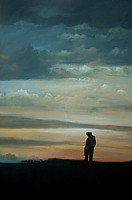
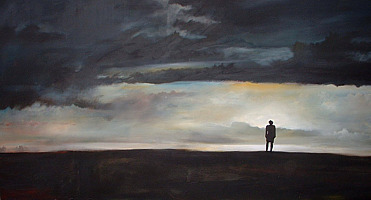
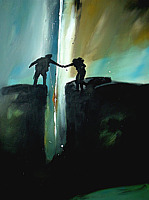
Anthony Boswell: Soldiers in Silhouette, large-scale twilight canvases Anthony studied graphic design at Birmingham and then spent a short while in advertising. He has lectured on his own drawing courses and had local exhibitions of work with both private and corporate sales. He now works on his current projects after both landscape, figure and abstract work. His works are often large scale.
unique relationship with the landscape by living and dying within it. The paintings should encourage solitude, peace and storytelling, bringing subject and viewer together. I aim to pave the way for remembrance and feelings for the individuals rather than a broad sweep of history. I aim not to portray sentimentality but empathy, not sadness but a narrative of distant or shared experiences.' |
||
| War
Art and Artists : Places of Peace and Memory
|
||
 |
Andy Bradford: The
Disabling Effects of Global Conflict Andy Bradford's Pro Patria represents a mock museum cabinet (900mm x 900 mm x 225 mm) mounted on a low plinth around which the viewer circulates. The cabinet was made of clear acrylic sheet onto which the words 'Pro Patria' were screenprinted. The base of the cabinet was also screenprinted onto yellow acrylic sheet. The image is taken from the Science Museum in London and shows a disfigured survivor from the First World War; the subject of an early attempt at facial reconstruction. Inside the wooden cabinet a pair of wooden crutches is suspended, painted in 'patriotic' colours. The piece was an installation commissioned by the Imperial War Museum in 1992 for a show entitled Up in Arms for which the artist also created the publicity material and posters. 'The piece mocks jingoistic attitudes to war and its representation in formal museums and the media, and directs the viewer towards the disabling effects of global conflict. The title is taken from the Wilfred Owen poem 'Dulce et decorum est', in which the poet exposes 'the old lie' that 'it is both sweet and fitting to die for one's country'. Andy Bradford studied at Central St Martins School of Art in
London (graduating with a first class honours in 1992), he studied
printmaking at the University of the West of England, Bristol
from 1992 - 1994, and gained an MA in Fine Art from Chelsea College
of Art and Design in 1995. |
|
| War
Art and Artists : Places of Peace and Memory |
||
 |
Rob Perry: Battlefield
Painter, Vimy, Verdun, the Somme Auschwitz, Verdun as sites of memory Landscape painter born in the Black Country, West Midlands, UK. Perry exhibited a series of drawings and painting as 'Echoes of War' at Wolverhampton Art Gallery 13 December 97 - 31 January 1998. The artist wrote : "This series evolved from a long running anti-war theme dating back to my time at Art College and was my response to an invitation to exhibit at Le Centre Mondiale de la Paix at Verdun, France. An expedition to Auschwitz affected me profoundly and determined me to dedicate the work to supporting Amnesty International." www.robertperry-artist.co.uk/exhibition-rental-lecture-service/verdun top |
|
| War
Art and Artists : Places of Peace and Memory |
||
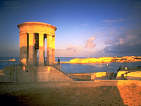  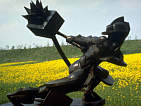
|
Michael Sandle RA FRBS:
Anti-war Commemorations British sculptor (born 1936) renowned for his provocative commemorative works 'Twentieth-Century Memorial, 'Fuck the Media', 'George and the Dragon', and The Malta Siege Memorial. DJ: "I was interested to know how you felt about showing Twentieth-Century Memorial after all the changes that have occured during the last ten years. And about showing it this year (1995) the 50th anniversary of the end of the Second World War." MS: "It isn't related to the First and Second World War directly, but obviously I'm pointing the finger at the whole of the twentieth century which is absolutely soasked in blood. The original reason for doing it was the war in Vietnam. It was going to be called The Mickey Mouse Machine Gun Monument for America. My reaction to what I thought the Americans were doing ... We are living in a time of heroic decadence, if anything it's becoming even more so - stuperndously decadent. Mickey Mouse, symbol of capitalism, fits in with today because capitalism is not decaying but is rampant." Sandle in conversation with David Jacobsen, Sculpture No.2, October 1995. see also Geometry of Rage, catalogue Arnolfini gallery, Bristol 1995 ISBN 0 907738 09 5, also, The Battle of Britain Monument, Theo Crosby and Michael Sandle, Pentagram, 1987 top |
|
| War
Art and Artists : Places of Peace and Memory |
||
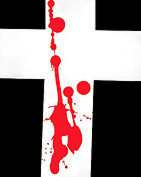 |
Karl Townsend: Graphic
Cross of Peace "Fatalities of war. Many of those who died in battle would never be laid to rest. Their bodies had been blown to pieces by incessant shell fire and the fragments scattered totally beyond recognition. Countless other bodies could not be recovered during the fighting and were lost from view, entombed in decaying, crumbled shell holes or collapsed trenches or decomposing into the broken soil left behind. For me the cross symbolises and represents hope, freedom, liberation, independence, self government ... Let us honour those who so valiantly laid down their lives in the hope that such violence and atrocities cease to exist in the future ... Let us hope so." 'The single cross (pictured) is one of forty handmade for an installation ... each cross symbolising and representing one million either through death, or who were unaccounted for ...' top |
|
| War
Art and Artists : Places of Peace and Memory |
||
   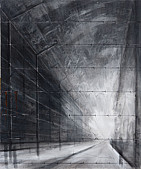 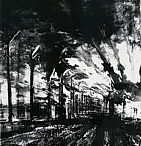 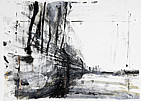
|
Phil Whiting: Places
of Mourning: ‘Ground Zero’ and 'Auschwitz-Birkenau' Phil Whiting is a painter currently working within the genre of War Art.
Phil Whiting's work is multifacted and among other subjects he has painted selected 17th century plague sites in Norfolk. He also won an Arts Council Award in 1981. Phil Whiting's girlfriend was callously gunned down in 1985, in considering this Phil reflects that:
Phil Whiting later moved South West to Helston on the Cornwall peninsula where he began painting what had by that time become Cornwall's post-industrial hinterland. Later still Phil began working upon his series "Places of Mourning in the Western World", during which he painted a selection of sites throughout Europe and the United States. In October 2004 Phil made some sketches at 'Ground Zero' site of the infamous '9/11' World Trade Center tragedy and in December visited 'Auschwitz-Birkenau'. Phil Whiting recently accompanied the charitable Organisation "Funds for Refugees in Slovenia" to Srebrenica - the scene of the infamous massacre during the 1990's, of which he says
the noses of the Serbian Police." You can find out more about Phil Whiting and his work by visting his section at: www.axisartists.org.uk/seCVPG.aspx?ARTISTID=9453 You can also e-mail Phil Whiting at: philwhitinglezerea@fsmail.net top back to featured artists |
|